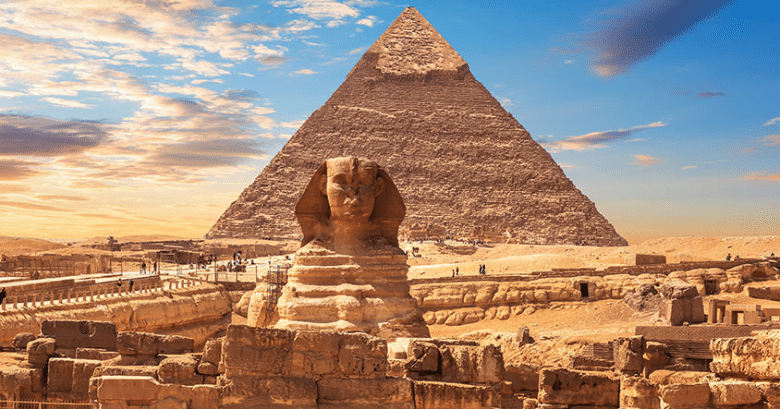Who is buried in the Sphinx’s tomb? No, it is not the Sphinx or anyone for that matter—either mythical or human. Even though the 4,500-year-old part-lion, part-human Great Sphinx is positioned between two actual tombs, namely, the Pyramids of Giza in Egypt, the Sphinx is not a tomb. Rather, this imposing 65 ft. tall x 240 ft. long sandstone structure, considered the largest rock-carved sculpture on earth, serves as a formidable, if frozen-in-time, bodyguard. Legend has it that the Great Sphinx keeps watch over the tombs housed in the two Giza pyramids—crypts containing the remains of the 4th Dynasty’s Pharaoh Khufu and his son, Khafre, respectively.
As spectacular as this colossal object of worship is (or was), not every Egyptian ruler down the ages appreciated its magnificence. Or considered it worthy of worship. It was a neglected deity, making the world’s largest “sandcastle” ever built rather lonely. Its neglect by the faithful (as faithful as one can be when they have the pick of 1,200 gods to choose from) was worsened by the fact that the Great Sphinx, along with its surrounding smaller sphinxes, lay dormant for centuries off and on as the desert sands swallowed them up into obscurity. Only the Great Sphinx’s giant head, topped by an Egyptian headdress, remained visible.
The Sphinx would be reborn twice, once during Egypt’s New Kingdom era (circa 1539-1075 BC), when, in a clever piece of propaganda, a young pharaoh used the Sphinx to tie his reign to the pharaohs that preceded him during Egypt’s Old Kingdom era. In that ancient climate that was replete with a throng of gods (only for a brief period was Egypt a monotheistic society during which time they worshipped just one god), the young ruler’s strategy proved to be a successful political ploy in his bid to win friends and influence the populace.
As to the Sphinx’s appearance, this mythical structure is almost perfectly preserved except for one obvious defect—it is missing a nose. According to Muslim historians, in the 14th century, a Sufi Muslim named Muhammad Sa’im al-Dahr sliced off the Sphinx’s snout. This act angered the Egyptian people, who believed that the imposing lion-human statue was divine. However, in this Islamic zealot’s view, only Mohammed (that is, “the” Mohammed) was worthy of adoration.
Regardless of its fluctuating social and spiritual status throughout the centuries, few would argue that the carving is a resplendent reflection of man’s creative and engineering talents, particularly in an ancient era where such edifices seemed physically impossible to erect. Modern-day visitors to this awe-inspiring structure will most likely not be bowing their heads in adoration, but they will, like the rest of the world, continue to scratch their heads as to how exactly the Sphinx, like the pyramids, was built.
Interestingly, when the structure was finally unearthed in 1905 from its desert grave, it was revealed that much of the erosion of the Sphinx was due to water. While a certain contingent postulates this erosion was due to the biblical account of the flood, geological evidence, and even the Bible itself, does not support that theory. Not only does the timeline not fit (overwhelming evidence shows that the Great Sphinx, along with its adjacent temple complex, was built post-flood), but geologists maintain that the amount of erosion of solid rock is far too much to have occurred during a single flood event.
Despite the fanciful religious myths that have been created, the Sphinx does have a significant connection to the Bible. It highlights the incredible power and wealth of the ancient Egyptians, underscoring the formidable challenge that they posed to ancient Israel and God’s chosen people.
Stand in awe of the 4,500-year-old architectural marvel known as the Great Sphinx that reinforces how advanced of a civilization Egypt was, offering living proof of how formidable a foe ancient Egypt really was to Israel and God’s chosen people.
Email Cindy at cindy@signaturetouchtours.com or
visit www.signaturetouchtours.com to learn more about travel to the Lands of the Bible.
Originally Posted at israeladvantagetours.com

